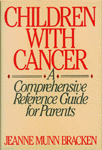Children With Cancer : A Comprehensive Reference Guide for Parents
Author: Jeanne Munn Bracken |
Jeanne Munn Bracken is a reference librarian whose own child survived cancer. Her daughter was diagnosed in 1977, and at that time there were no helpful books for parents to turn to for answers. Ms. Bracken spent much time researching her child's cancer, but realized that not every parent of a cancer patient has the experience in research that she has. She thus felt compelled to write this guide, and as she states: "I offer this book to help laymen understand what we're up against, what we can do about it, and where to go for help."
The book is divided into four sections; the first describes the different kinds of childhood cancers. This section begins by defining cancer, and explaining its probable causes (genetics, medicines, chemical causes, viruses and congenital problems). Each chapter then discusses a particular cancer, ranging from the more common leukemia to a chapter on rare tumors such as teratomas and endodermal sinus tumor. Each chapter defines the cancer, its incidence and symptoms, describes the steps taken in diagnosis, treatment, possible complications, and prognosis.
The second section discusses treatment, covering surgery, radiation therapy, chemotherapy, experimental treatments, and even chapters on unproven and future treatments. This section begins by familiarizing the reader with cancer centers, the roles of pediatricians and oncologists, and the importance of second opinions. These are all valuable things to know, as many decisions concerning these issues must be made prior to starting treatment. The author then covers the treatments in an honest and frank manner, often drawing from her own experience.
The third section describes how to live from day to day with a child with cancer. This section discusses emotional and medical problems, how to make the most of hospital and clinic visits, finances, continuing schooling for the patient, cancer in adolescents, and death. The author makes this section strong and meaningful by using her own experience, and those of friends. She discusses the wide spectrum of emotions parents go through, and repeatedly advises communicating with doctors and the rest of the hospital staff, especially mental health professionals. She also discusses all the medical problems one may have to face (fever, constipation, diarrhea, vomiting, diet, sleep, etc.).
The fourth and final section provides names of organizations and clinics. The author does an incredible job, providing endless names and numbers, including those of international organizations. The book ends with an appendix detailing medical tests, and a glossary of terms.
This book is a valuable source to any parent whose child has been diagnosed with cancer. It provides both medical and emotional advice in a very easy to read style. The author does state that "I must emphasize here that I am not a doctor. I have gathered the material in this book from many published sources, but it is not my intention to provide a scholarly review with footnotes and an extensive bibliography of professional reading." She does provide a few suggested readings at the end of each chapter, though most of her references are older textbooks. She does not claim that this is a professional reference, and readers should bear this mind while reading this publication. The book was published over a decade ago and is flawed in some of the statistics and details of the current standard in diagnosis and treatment. This book does however, serve as a good foundation for parents desiring to have a quick and easy to read reference on childhood cancers. As always, one must always confirm information published in this book with a pediatric oncologist.


